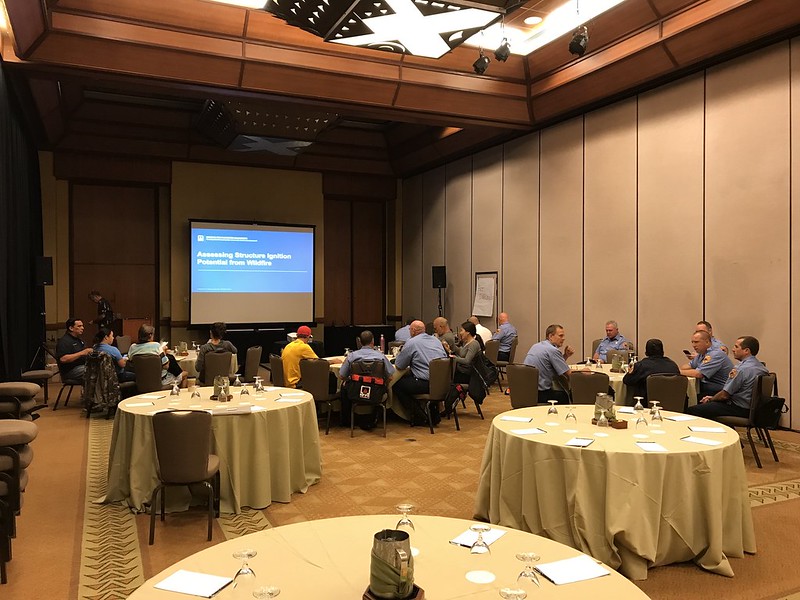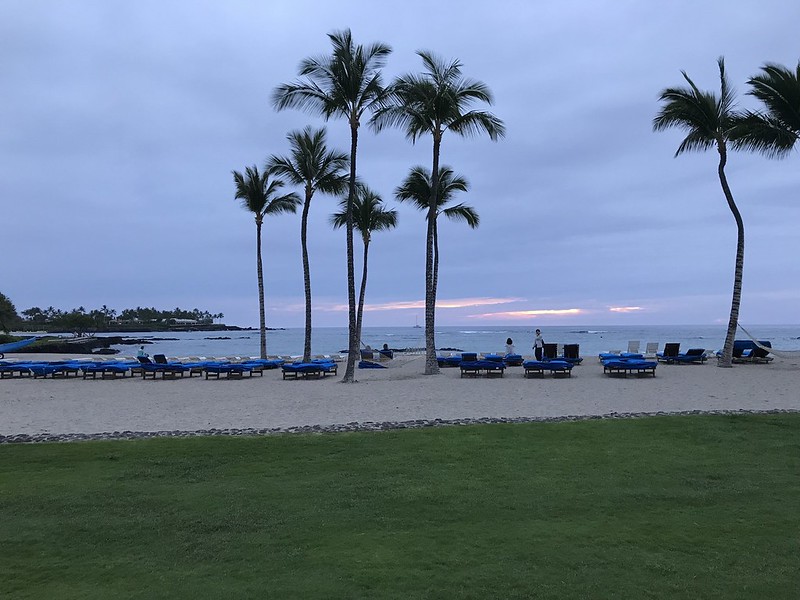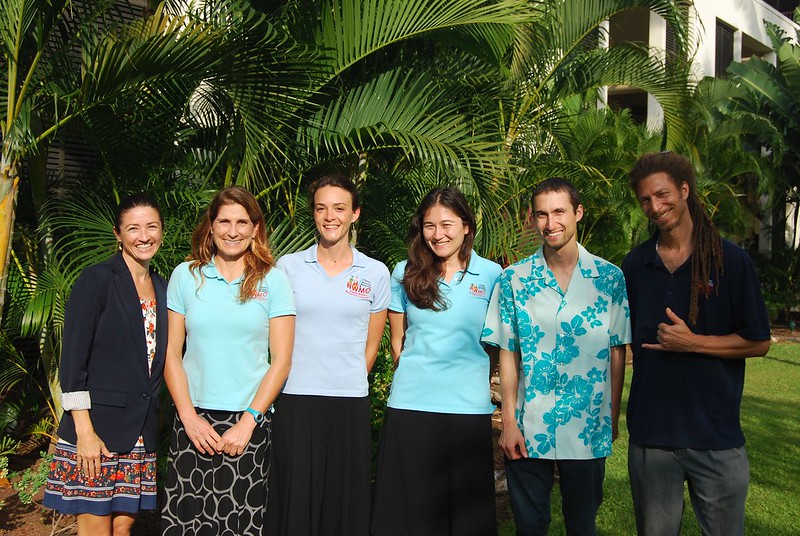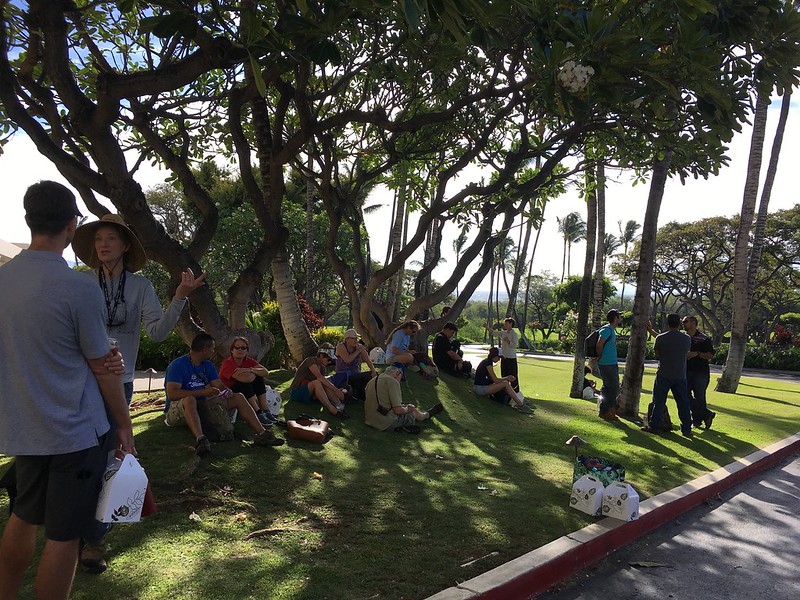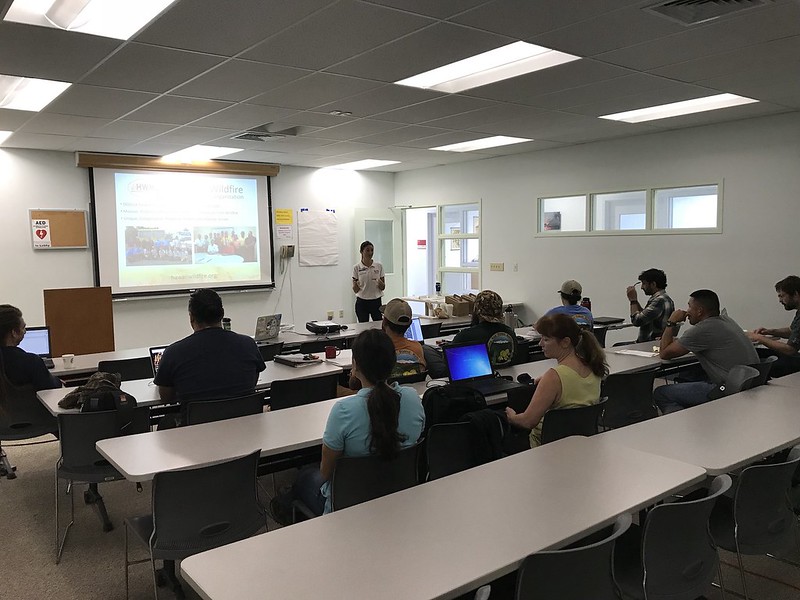On June 4, HWMO presented at a community meeting about the latest wildfire updates, including on Firewise Communities and the Wildfire LOOKOUT! campaign. The meeting was a regularly held public meeting for the South Kohala Community Development Plan, or CDP for short.
Hawaii Wildfire Summit 2018
Over the years, HWMO has come to understand that wildfire-related challenges are faced by a wide array of professionals and citizens, including more than just those focused on emergency response. HWMO, through a grant from the U.S. Forest Service, held the first ever Hawaii Wildfire Summit between April 30 and May 4 at the Mauna Lani Bay Hotel & Bungalows to bring together not just fire professionals, but people working in riparian and marine conservation, cultural resource protection, the visitor industry, planning professionals, and community groups from across Hawaii, the Western Pacific, and the rest of the U.S.
Pre-Summit: NFPA Assessing Structural Ignition Potential for Wildfire Course
The first two days were dedicated to the NFPA course on Assessing Structural Ignition Potential from Wildfire. Participants included firefighters, land managers, and homeowners who learned the ins and outs of fire and its interaction with the built environment. Wildland fire expert, Pat Durland, who traveled from the mainland to teach the course, also shared valuable information on the latest research for improving the survivability of a home during a wildfire.
Summit Main Event
The main event began on Wednesday, May 2, kicking off two days packed with presentations and workshops from over 40 speakers, including our two keynote speakers, Gloria Edwards of Southern Rockies Fire Science Network and Dr. Steve Quarles of the Insurance Institute for Business & Home Safety. A wealth of knowledge was shared throughout the summit by these speakers with the diverse audience. Speakers highlighted lessons learned, best practices and innovations in wildfire protection. Check out the list of speakers and their bios by clicking the buttons below.
HWMO emphasized the importance of using creativity and outside-the-box thinking to get out of our comfort zones, a point that keynote speaker Gloria Edwards so eloquently urged in her presentation. To spur creativity and collaborative dialogue, HWMO encouraged participants to take part in several activities during the breaks and the first evening's meet-and-greet:
* A collaborative Summit to Sea art project
* A collaborative ideas sharing space
* Casting ballots for a statewide youth wildfire prevention bookmark contest. Submissions were from students at Kamaile Academy in Waianae and Kohala and Waikoloa Schools on Hawaii Island.
Smokin' Word
To cap off the event and to further encourage participants to use their creativity and get out of their comfort zones, we held a "Smokin' Word" open mic. Various brave volunteers, from local fire chiefs to representatives from national programs, gave spoken word performances about "why we do what we do, what we are aiming to protect, and to ignite applause and laughter." We were extremely pleased to see our colleagues dig into their creative space and shake off some nerves to share their great pieces. Professional spoken word artist (and HWMO Community Outreach Coordinator), Pablo Akira Beimler, rounded out the open mic with a performance of his poem in tribute to the summit and all of the inspiring work happening by the people in the room to make Hawaii a better, safer place to live.
We also had a great turnout of Firewise Community members from Hawaii Island and Maui-- almost all Firewise Communities in Hawaii were represented! Firewise committee members Lisa Chu-Thielbar (Kanehoa), Gordon Firestein (Launiupoko), and Diane Makaala Kanealii (Honokoa) presented lessons learned and background about their Firewise efforts during the general session on the 2nd day. We had a Firewise gathering at the end of the 2nd day where participants played "get to know you bingo" to frantically and comically break the ice. From this point onward, HWMO is committed to forming a statewide peer learning network between all of the Firewise Communities.
Field Workshop
On the final day of the summit, a large group of the summit attendees hopped aboard vehicles to caravan around the South Kohala area to visualize much of what was discussed indoors at the Mauna Lani. The Pacific Fire Exchange field workshop began at the Upper Waikoloa Road Intersection to ground the participants in a sense of place and seeing a landscape-level view of the summit-to-sea watersheds of South Kohala. Then, it was on to Wai Ulaula Waimea Nature Park, where participants learned about watershed planning and about the local native forest. The following stop helped participants understand the wildfire threat that threatens the native forests and the subsequent post-fire flooding that has vastly impacted Hawaii's shorelines. What better place to talk about wildfire than in Kawaihae, where the 2014 wildfire burned thousands of acres and threatened many homes, burned millions of dollars of timber, and post-fire flooding shut down businesses and impacted the livelihoods of local residents. Representatives from Hawaii County Fire Department and National Park Service shared their lessons learned from responding to the massive fire.
After lunch with a beautiful view of the South Kohala Coastline and a jolt from an earthquake in Kilauea, the group walked to the Puu Kohola Heiau visitor center to learn the history of the sacred site. The group then walked along a trail to learn more about the conditions that are ripe for wildfire in Kawaihae. They continued walking down to Pelekane Bay, the site of intense post-fire runoff and coral reef decay.
The field workshop ended in Puako where Peter Hackstedde shared about the community's efforts to create a large fuelbreak behind homes and their recent Firewise Community recognition efforts. Paniau was the final stop and a nice place to wrap-up the summit to sea discussion. Some workshop participants stayed for a snorkel tour of the reef.
Great job, Melissa Kunz, on coordinating such a smooth, exciting, and informative field workshop!
Here is a thank you letter from our Executive Director, Elizabeth Pickett, to the summit participants:
Kauai Watershed Alliance Presentation
Flammable fuels on Kauai.
On April 12th in Lihue on Kauai, Pablo Akira Beimler, HWMO’s Community Outreach Coordinator, gave a presentation to the Kauai Watershed Alliance. The KWA is a multi-partner alliance that encompasses 144,004 acres of Kauai’s uppermost watershed areas, where there are rich remnants of native forest important to the health of the Garden Island. Pablo introduced the group to an important effort that HWMO was working on and invited KWA members to be a part of the effort. What’s the effort? We are conducting a statewide rapid assessment to better understand the vegetation management needs and priorities of landowners and land managers. This will help all of us plan, coordinate, and implement effective fuels management projects at the landscape-level, rather than in a piece-meal fashion.
WUI Conference 2018
Opening day of the conference.
HWMO’s Pablo Akira Beimler flew to Reno to join over a hundred other professionals working in wildland-urban interface wildfire issues, from fire chiefs to insurance agents to wildfire mitigation specialists from across the U.S. and abroad. The conference was a prime opportunity for HWMO to stay connected to the latest in wildfire solutions and with national partners including NFPA, Firewise USA, IAFC, ReadySetGo!, Cohesive Strategy, and Fire Adapted Communities. At the end of the conference, Pablo joined a Fire Adapted Communities Learning Network session, which gave us an additional opportunity to connect with others doing similar work in other parts of the U.S.
Collaborative Vegetation Management Mapping Workshop 1 - Mauna Kea Partners
Mauna Kea partners were busy at work mapping fuels management projects on Google MyMaps.
Across the state, there are many vegetation management projects that are helping to reduce the fire threat around natural/cultural resources and near communities. However, there currently isn’t a way to track all of these projects and the desired areas for future management of flammable vegetation. Stemming from an idea communicated to us from an HWMO Technical Advisor and US Fish and Wildlife partner, Dawn Bruns, we have received US Forest Service funding to create a statewide database and map of vegetation management projects.
Meeting participants worked in groups to map their fuels management projects.
We held our first workshop with our partners from the Mauna Kea Watershed Alliance (MKWA) and Three Mountains Alliance (TMA) on January 30 at the Hawaii Innovation Center in Hilo. Elizabeth Pickett, HWMO Executive Director, started the workshop off with an introduction to the project, emphasizing how important this project will be for future collaborative fuels management projects. Dr. Clay Trauernicht, Wildfire Extension Specialist of University of Hawaiii CTAHR Cooperative Extension and Co-Coordinator of the Pacific Fire Exchange, gave a brief course on fire science and pre-fire planning and management. Pablo Akira Beimler, HWMO Community Outreach Coordinator, followed with a training on Google MyMaps, which was the main platform we used to collect data from meeting participants.
Cheyenne Perry, Coordinator of Mauna Kea Watershed Alliance, points out areas where he hopes there can be collaborative vegetation management projects on Mauna Kea.
For the rest of the workshop, meeting participants began mapping their current and desired vegetation management projects on Google MyMaps. Once the projects were mapped, we projected the new data onto a screen and had the groups share about their work areas and what they envision for a more fire-safe Mauna Kea.
HWMO will be spending the rest of the summer holding workshops across the islands. If you would like to participate, please contact admin@hawaiiwildfire.org.
Special mahalo to MKWA Coordinator, Cheyenne Perry, and TMA Coordinator, Colleen Cole, for being our first workshop partners. Mahalo also to Mauna Kea Forest Restoration Project and U.S. Army-Garrison for joining our workshop and being our workshop “guinea pigs”!
FAC Net Webinar on Sustained Community Wildfire Engagement
HWMO is a proud affiliate member of the Fire Adapted Communities Learning Network where members from across the nation share their lessons learned from moving communities towards greater resilience to wildfires. On January 11, HWMO Community Outreach Coordinator, Pablo Akira Beimler, facilitated a panel discussion on a network-wide webinar. The panel topic was on “Sustained Community Wildfire Engagement.” HWMO and three other speaks from across the U.S. shared what has and hasn’t worked for them in terms of motivating communities towards self-sustaining wildfire risk reduction. Community engagement and self-reliance in wildfire protection can lift a remarkable weight off of agency and non-governmental groups. It takes everyone to create fire-adapted communities.
Check out the panel discussion videos below, which were recorded and posted on YouTube by our partners from FAC Net.
Major mahalo to FAC Net for the opportunity to lead this discussion and to our friends from FireWise of Southwest Colorado, Montana Department of Natural Resources & Conservation, and Project Wildfire (in Oregon) for sharing their expertise.
Kanehoa Firewise Native Plant Workshop
Kanehoa, a subdivision halfway between Kawaihae and Waimea on Hawaii Island, was the second community in Hawaii to become a nationally-recognized Firewise Community. Since 2015, they have contributed hundreds of volunteer hours and linked with HWMO for a couple of $5,000 grants to remove flammable vegetation from along internal roadsides. As part of the next step in their action plan, they hope to plant more native vegetation along common areas and around their own homes.
2016 Firewise Day: Kanehoa residents took fuels reduction into their own hands with a $500 grant from State Farm and $5,000 grant from HWMO to remove haole koa from roadsides. Here is a before...
...and after.
Native dryland plants can be an added defense for your home, though like with any plants, site location and what you plant matters greatly for fire safety reasons. On November 4th, Kanehoa Firewise Committee members invited HWMO to join them for a Firewise Native Plant Workshop. Fifteen community members listened in as guest speaker Jill Wagner of Hawaii Island Seed Bank talked story about the importance of restoring native plants in our own communities. The area between Puu Waa Waa to Kohala Mountain on the leeward side was one of the most biodiverse areas in Hawaii, she shared. Years of drought, invasive species and disease stress, overgrazing, climate change, and wildfire have contributed to the demise of the native forests, which act as important watersheds. We have seen some success in recent years towards preserving and restoring these native forests with the emergence of strong conservation partnerships and efforts, better grazing practices targeted towards conservation and wildfire risk reduction, and wildfire protection projects that span the South Kohala area. However, there is still a lot to be done and we can all play a large role even around our own homes.
Ms. Wagner brought in a few native plants of her own for Kanehoa residents to pass around and get to know better. She enlightened us on ground covers such as iliee, akia, pohinahina and pau o hiiaka; shrubs such as aalii, aweoweo, and alahee; and trees such as mamane, lama, ohe makai, and wiliwili. If these names are unfamiliar to you or you would like to learn more, click on the links below.
Firewise Workshop 2018 in Boise
HWMO had the honor on October 31 to share about its Firewise Communities successes (and challenges) at the national Firewise Workshop hosted by the National Fire Protection Association in Boise, Idaho. Community Outreach Coordinator for HWMO, Pablo Beimler, presented on the importance of laying the foundations for community-wide grassroots and sustained actions towards becoming a Firewise Community. This requires building autonomy, pride, inspiration, and enthusiasm in community members, along with agency and governmental support.
View of Boise from the foothills near the city.
Hawaii was well-represented at the workshop that was held at the Grove Hotel. Representatives from Honolulu Fire Department and DLNR Division of Forestry were there with HWMO, thanks to funding support NFPA. We were informed about updates relating to Firewise and joined interesting group discussions regarding the future of wildfire risk reduction work in the U.S.
As an added bonus, with our friends from HFD and DOFAW, we took part in a two-day training on assessing the Home Ignition Zone (HIZ). The training was taught by two extremely knowledgeable wildland fire experts: Jack Cohen, who many consider being a father of modern wildfire mitigation theory and practices, and Pat Durland, who has 30 years of experience as a wildland firefighter and mitigation specialist. Together, they gave engaging lessons on fire ecology and science, the sociology behind assessing homes, and more. On the final day of the training, we hopped on the bus with the other training participants, who hailed from across the U.S., and practiced assessing home ignition zones in a local Firewise Community.
Trainees practicing their new home ignition zone assessment skills at a home in a local Firewise Community.
Jack Cohen (right) provides insight regarding home ignition hazards around a practice home.
Big thanks to NFPA for inviting and flying us to Boise to share about our efforts and learn from experts in the field!
Waikii Ranch Firewise Hazard Training and BBQ
Community members from all over Waikii Ranch participated in the community's first Firewise Day on September 23, 2017.
Waikii Ranch, which is surrounded by fire-prone grasslands on all sides, is a community near Waimea that is well on its way to being one of the next nationally-recognized Firewise Communities as of 2017. They took another major step on September 23 by hosting a Firewise Hazard Training and BBQ, which qualified as their annual Firewise Day. Over 25 community members joined in to listen to presentations from HWMO and our partners from Hawaii Fire Department, U.S. Army-Garrison Fire and Emergency Services, and DLNR Division of Forestry and Wildlife. HWMO’s Pablo Beimler gave a presentation on wildfire impacts, background on wildfire preparedness programs (Ready, Set, Go! and Wildfire Lookout!), and a brief intro to the Firewise Communities Recognition Program.
From left to right: Gary Grisham (Waikii Ranch Firewise Committee), Jacob Witcraft (DLNR DOFAW), Pablo Beimler (HWMO), Chief Eric Moller (US Army-Garrison, FES), and Captain Bill Bergin (HFD). Photo credit: Lynn Scully.
U.S. Army’s Chief Eric Moller spoke thereafter with the main message being that by becoming a Firewise Community, residents were taking an important step towards protecting themselves as well as the lives and safety of first responders. Captain Bill Bergin from HFD followed with several Firewise tips and background on some of the fire issues and history in Waikii. Jacob from DOFAW’s State Tree Nursery also spoke about the importance of creating defensible space and recommended the community plant more native trees and understory to reduce wildfire risk. To wrap up the presentations, a resident of Puu Kapu who lost her home in a recent brushfire gave a first-hand account of her harrowing experience evacuating the fire. She stressed the importance of planning ahead and it was a truly courageous thing for her to share her story in front of so many people.
After the speakers shared their thoughts, a member of the Waikii Ranch HOA put on a Firewise video outlining tips on Firewise landscaping and home fire-proofing.
The event concluded with a BBQ where fire officials mingled with community members and enjoyed delicious grindz. Thank you Waikii Ranch HOA for hosting all of us and being a part of the growing Firewise movement in Hawaii.
Kohala Waterfront Firewise Meeting and Ready Set Go! Workshop
Kohala Waterfront homeowners joined HWMO and the Firewise Committee to learn more about how they could help the community become a nationally-recognized Firewise Community.
Kawaihae is becoming a hot bed, not just for wildfire, but for grassroots community efforts to reduce the wildfire threat in the fire-prone area. Kohala-By-The-Sea and Honokoa subdivisions have received Firewise Communities recognition inspiring Kohala Waterfront, a newer subdivision on the makai side of the highway opposite of the two other subdivisions, to pursue certification for 2017.
On August 17, HWMO and Kohala Waterfront Firewise Committee hosted a meeting of twelve concerned and enthusiastic Kohala Waterfront homeowners to hear highlights from the Firewise Community Hazard Assessment conducted by HWMO and Hawaii Fire Department a few months ago. We shared our concerns about the sea of buffelgrass that surrounded homes throughout the subdivision and unlimbed kiawe trees that were dangerously encroaching upon homes. Although it may seem daunting at first, Kohala Waterfront has a lot working towards their advantage, especially since they are a newer subdivision and can get the community going in the right direction by becoming a Firewise Community early on. We gave tips based on Ready Set Go! and Wildfire Lookout! on how residents could reduce the fire threat around their homes or better yet, as a community.
Kohala Waterfront is well on their way to becoming one of the next Firewise Communities, of which there are now nine in the state.


